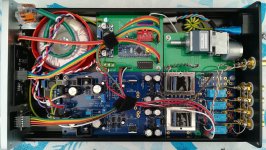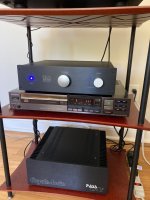Yet another Iron Pre SE with remote control in a small DAC case. My build has four inputs and is using an 10k ALPS motor pot.
Remote section is fed from the pre PSU at +/- 27V points using a DC-DC step-down converter to 12V. Additional current required for Nano and OLED = 50 mA and for motor pot when active = 100 mA. This means about 2W more power is needed but is no problem for 30 VA donut.
This preamp shows absolutely top drawer performance:
• Very low noise level. The highest level of interference components at 50 Hz is under -120 dB, which is practically hard to hear with 90 dB efficient speakers and my old ears.
• The tracking accuracy of the ALPS used is surprisingly good. At output voltages around hundreds mV, the deviation between both channels is about 1%.
• The response to the 10 kHz square wave is excellent. I didn't expect this from the Cinemags and was at least anticipating some slight overshoot or wavy spot. But I have been proven wrong in the best way possible.
• There are no high-frequency interference components visible or audible that could come from the used 150 kHz DC-DC converter. THD level measured with REW is a bit better than one showed in loopback mode. So, the limitations of my vintage soundcard are reached.
• The 6 dB gain is high enough and fits well to drive my F5 to its full power.
It took a long time to assemble but I really enjoyed it. Sound check with listening impressions will follow when the summer heat is over.
Many thanks to all involved who have made this possible.
Remote section is fed from the pre PSU at +/- 27V points using a DC-DC step-down converter to 12V. Additional current required for Nano and OLED = 50 mA and for motor pot when active = 100 mA. This means about 2W more power is needed but is no problem for 30 VA donut.
This preamp shows absolutely top drawer performance:
• Very low noise level. The highest level of interference components at 50 Hz is under -120 dB, which is practically hard to hear with 90 dB efficient speakers and my old ears.
• The tracking accuracy of the ALPS used is surprisingly good. At output voltages around hundreds mV, the deviation between both channels is about 1%.
• The response to the 10 kHz square wave is excellent. I didn't expect this from the Cinemags and was at least anticipating some slight overshoot or wavy spot. But I have been proven wrong in the best way possible.
• There are no high-frequency interference components visible or audible that could come from the used 150 kHz DC-DC converter. THD level measured with REW is a bit better than one showed in loopback mode. So, the limitations of my vintage soundcard are reached.
• The 6 dB gain is high enough and fits well to drive my F5 to its full power.
It took a long time to assemble but I really enjoyed it. Sound check with listening impressions will follow when the summer heat is over.
Many thanks to all involved who have made this possible.
Attachments
^ Have a cigar, you're gonna go far...
Still looking through your pics at some of the details. One thing I never considered (among many) is that I have a couple of the 4-gang alps motorized pots for differential builds. Your PCB to connect to the controller etc. is brilliant...
Once I learn a more, I've got that added to my list to try. I'm taking a KiCad class .... but it's going slowly.
I'm a lazy slug ... I need remote volume ... better yet... with instant mute function for phone calls etc....
Still looking through your pics at some of the details. One thing I never considered (among many) is that I have a couple of the 4-gang alps motorized pots for differential builds. Your PCB to connect to the controller etc. is brilliant...
Once I learn a more, I've got that added to my list to try. I'm taking a KiCad class .... but it's going slowly.
I'm a lazy slug ... I need remote volume ... better yet... with instant mute function for phone calls etc....
Congrats @ACnotDC please share more details on the Arduino based volume control and display pcbs that you have over their, it looks cool to control with a remote.
Thanks
Thanks
But using a resistive element as volumen control has not been used for the last 20 years?
Listen here at about 1:35 into the video:
https://www.psaudio.com/blogs/ask-paul/best-position-for-a-volume-control
What will you do about that? 🤔
Listen here at about 1:35 into the video:
https://www.psaudio.com/blogs/ask-paul/best-position-for-a-volume-control
What will you do about that? 🤔
well, you stumbled on another Tom Sawyer Fancy Fence
fact is - majority of audio products are utter drek, considering sound
majority of audio products, even those not in drek category, if having implemented Volume function - are having resistive attenuating network
there are some, having variable resistance in place of load for amplification stage , so sort of I/V converter stage ...... (remember Aleph L, for instance?)
and quite possible some other sorts but we are really speaking of exception of majority
of these exceptions I know - some were good, and some were disaster, sound-wise and durability-wise (example - Musical Fidelity A1, having "volume pot" connected as variable resistor in feedback loop ....... luckily situated in preamp stage)
reason why Volume controls in form of resistive attenuating cell are in majority of gadgets is simple - simplest to implement and pretty much cheapest to implement ...... and if done properly, good enough
now, that speaking of commercial production of audio gadgets
then you have area of Blind Faith, where you can find Inductive attenuators; hardly convenient for steady and big production;
I'm pretty sure that approach of Aleph L is sound-wise close to inductive approach, when properly done
fact is - majority of audio products are utter drek, considering sound
majority of audio products, even those not in drek category, if having implemented Volume function - are having resistive attenuating network
there are some, having variable resistance in place of load for amplification stage , so sort of I/V converter stage ...... (remember Aleph L, for instance?)
and quite possible some other sorts but we are really speaking of exception of majority
of these exceptions I know - some were good, and some were disaster, sound-wise and durability-wise (example - Musical Fidelity A1, having "volume pot" connected as variable resistor in feedback loop ....... luckily situated in preamp stage)
reason why Volume controls in form of resistive attenuating cell are in majority of gadgets is simple - simplest to implement and pretty much cheapest to implement ...... and if done properly, good enough
now, that speaking of commercial production of audio gadgets
then you have area of Blind Faith, where you can find Inductive attenuators; hardly convenient for steady and big production;
I'm pretty sure that approach of Aleph L is sound-wise close to inductive approach, when properly done
Attachments
Last edited:
I also love the braided power leads. 👍Your PCB to connect to the controller etc. is brilliant...
Braids are nice but at least in theory not the technique that provides the smallest loop area. But as long as it is quiet, who cares. I have done it myself several times.
Rega released a class A/B amp not too long ago placing an alps blue in connected to the feedback loop. My initial thought was «why?» and «can that endure the test of time?».well, you stumbled on another Tom Sawyer Fancy Fence
fact is - majority of audio products are utter drek, considering sound
majority of audio products, even those not in drek category, if having implemented Volume function - are having resistive attenuating network
there are some, having variable resistance in place of load for amplification stage , so sort of I/V converter stage ...... (remember Aleph L, for instance?)
and quite possible some other sorts but we are really speaking of exception of majority
of these exceptions I know - some were good, and some were disaster, sound-wise and durability-wise (example - Musical Fidelity A1, having "volume pot" connected as variable resistor in feedback loop ....... luckily situated in preamp stage)
reason why Volume controls in form of resistive attenuating cell are in majority of gadgets is simple - simplest to implement and pretty much cheapest to implement ...... and if done properly, good enough
now, that speaking of commercial production of audio gadgets
then you have area of Blind Faith, where you can find Inductive attenuators; hardly convenient for steady and big production;
I'm pretty sure that approach of Aleph L is sound-wise close to inductive approach, when properly done
So I still regard Rega as mainly a record player producing company. But what do I know
instead of listening and watching guys speaking generally of Audio, this is much more helpful in elevating one's ability to listen, in proper way
(especially taking some time to read at least one issue of Dope from Hope afterwards):
(especially taking some time to read at least one issue of Dope from Hope afterwards):
Can I just advocate for the Iron Pre for a minute here? This is hands down the most Roq en Roll preamp I've had in my system so far. I have an old Sony CD player, a CDP-302, that was on the fritz for a while. I fixed it today & put it back in my system & I didn't realize how much I missed my 90's alternative rock- Jane's Addiction, The Red Hot Chili Peppers, Radiohead, all that stuff where 'wall of sound' or mixed for 6dB of dynamic range or whatever was in vogue, just full fuzz full volume noise that can sound like crap on a system that isn't clean. This system is clean though, and the Iron Pre driving my Aleph 20 clone is just beautiful and forward and full of energy and nothing is missing and it's amazing to me how good this stuff sounds. The volume is up and I am dancing.
Attachments
I like the effect of some passive voltage gain in my system. Of course it's important to use some good iron that is driven properly. Papa, ZM, Mark J., these guys know how to do it right when they implement one.
The volume is up and I am dancing
that's - Blue LEDs singing
no other secret
Regarding gain:
I will soon put power to my SE Iron. If I am happy with the 6 dB setting in my system then the BAL version which also has 6 dB gain will give me 2x absolute output voltage compared to SE as my BAL out on DAC is specified as 4 Vpp_max vs. 2 Vpp_max for SE output.......or I am wrong here?
I will soon put power to my SE Iron. If I am happy with the 6 dB setting in my system then the BAL version which also has 6 dB gain will give me 2x absolute output voltage compared to SE as my BAL out on DAC is specified as 4 Vpp_max vs. 2 Vpp_max for SE output.......or I am wrong here?
- Home
- Amplifiers
- Pass Labs
- Iron Pre Essentials Kits For The DIYA Store - Register Your Interest





 ... Welcome to the machine
... Welcome to the machine

